Our Instpration
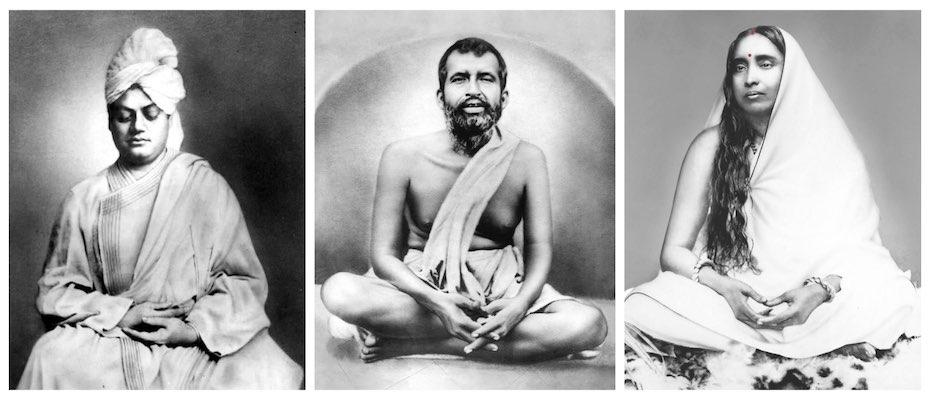
Philosophy of the Ramakrishna Order
“Atmano Mokshartham Jagat Hitaya Cha – For the emancipation of one’s self and the good of the universe” is the raison d’etre of the Ramakrishna Order.
The truths Bhagawan Shri Ramakrishna directly perceived and imparted to his disciples, broadcasting those truths to society at large and striving for the material and spiritual elevation of mankind are the Order’s basic goals. Once, while discussing liberation, Swami Vivekananda expressed his desire for personal liberation. Shri Ramakrishna, expressing his disappointment, said, “I thought you will be a gigantic banyan tree giving shade and comfort to the people”. Realizing the true import of his expression, Swami Vivekananda translated his Master’s wish by founding an organization, Ramakrishna Math & Ramakrishna Mission, where people from all castes, religions, and economic & social strata are welcome.
The narrowness of “organizational culture” is incompatible with the motto of Ramakrishna Order. Nevertheless it fervently adheres to Shri Ramakrishna’s cardinal teaching: the divinity of man and the service of God in man. Swami Vivekananda realized this teaching in his own life. “Shiva Bhave Jiva Seva – Service to God-incarnate as humanity” is the principle which the Swami taught . He inspired Sannyasis to be not only concerned with their own self-realization but wished that, seeing Narayana in all, they engage in selfless service of the destitute, the weak, the homeless, the crippled, and the needy. That is why he founded the Ramakrishna Order with well defined guidelines.
The Ramakrishna Order is not bound by any sectarian ideology or religion or methodology. It was the dream of Swami Vivekananda to bring the lofty ideals of Vedanta, which were confined to forests for centuries, into the daily life of individuals.
Ramakrishna Order is a prime movement giving expression to his dream. A broad and liberal outlook, the well-being of humanity, has motivated it from its very inception. That is why it has several branches not only in India but also abroad.
“The aim of the Sangha is to propagate the values, which Shri Ramakrishna advocated and practiced in his life to help others in their mental and spiritual development. Understanding that all religions are the manifestations of one eternal religion; the objective of the Sangha is to make an effort to establish brotherly feelings in the followers of different religions.”
– Swami Vivekananda
The Emblem of the order

Swami Vivekananda himself concieved with the idea of the emblem of the Ramakrishna Order. About the design he explained:
“The wavy waters in the picture are symbolic of karma, the lotus of bhakti, and the rising-sun, of jnana. The encircling serpent is indicative of yoga and awakened kundalini shakti, while the swan in the picture stands for the Paramatman (the Supreme Self).
Therefore, the idea of the picture is that by the union of karma, jnana, bhakti and yoga, the vision of the Paramatman is obtained.”
“Our main problem is to be free. It is evident then that until we realise ourselves as the Absolute, we cannot attain to deliverance. Yet there are various ways of attaining to this realisation. These methods have the generic name of Yoga (to join, to join ourselves to our reality). These Yogas, though divided into various groups, can principally be classed into four; and as each is only a method leading indirectly to the realisation of the Absolute, they are suited to different temperaments. Now it must be remembered that it is not that the assumed man becomes the real man or Absolute. There is no becoming with the Absolute. It is ever free, ever perfect; but the ignorance that has covered Its nature for a time is to be removed. Therefore the whole scope of all systems of Yoga (and each religion represents one) is to clear up this ignorance and allow the Atman to restore its own nature. The chief helps in this liberation are Abhyasa and Vairagya. Vairagya is non – attachment to life, because it is the will to enjoy that brings all this bondage in its train; and Abhyasa is constant practice of any one of the Yogas.”
– The Complete Works of Swami Vivekananda
Volume 8 [ Page : 152 ]
FOUR PATHS OF YOGA
History of Pune Math
Stay of Swami Vivekananda at the house of Lokamanya Tilak

“After this incident [the Swami’s discourse at the Deccan Club] many people of the city started flocking around the Swami. The Swami used to talk to them on the Gita and the Upanishads. But the Swami never told his name….When people started coming to him in large numbers, he said to me one day, “I am leaving tomorrow”; and really he went next morning, before anyone in the house had woken up.”
– Lokmanya Bal Gangadhar Tilak
[Life of Swami Vivekananda by His Eastern And Western Disciples]
Swami Vivekananda, during his wandering days, arrived at Pune (Poona as it was earlier called) from the Bombay Presidency, by train during September 1892. It was during this time that he was introduced to Lokmanya Bal Gangadhar Tilak, the renowned scholar and patriot, who happened to be his fellow passenger.
Swamiji stayed with Tilak at his house for eight or ten days. Tilak was impressed by the austere ways of the Swami. He also was witness to the oratory of the young Swami which was displayed at the Deccan Club in Hirabag area of Pune. Soon after, many young men and people of the city began flocking to the Swami. The Swami left the city immediately and proceeded on to the Kolhapur and to Belgaum. Tilak later met Swamiji at Belur Math.
 The room where the Swami stayed with Tilak – Vinchurkar wada, is preserved to this day and often visited by the devotees who come to the Math. All the three doors of this room open into the same hall. The name of the place is Vinchurkar Wada, named after Sri Vinchurkar, who was the maternal uncle of Tilak. It was revealed that the now famous Ganesh Festival of Maharashtra was started by Tilak in this very room.
The room where the Swami stayed with Tilak – Vinchurkar wada, is preserved to this day and often visited by the devotees who come to the Math. All the three doors of this room open into the same hall. The name of the place is Vinchurkar Wada, named after Sri Vinchurkar, who was the maternal uncle of Tilak. It was revealed that the now famous Ganesh Festival of Maharashtra was started by Tilak in this very room.
Other Disciples of Sri Ramakrishna

Swami Shivanandaji (Mahapurush Maharaj) stayed at Someshwar Mandir, Raviwar Peth, in the heart of Pune city. During those times, this temple was the only refuge to wandering sadhus. Shivanandaji stayed there for 3 days before moving on Southwards.

Swami Vijnananandaji, a brilliant academic throughout his life, studied in Government Engineering College, Pune and obtained his degree in Civil Engineering. The wonderful architecture of the temple of Sri Ramakrishna at Belur Math is a testimony to the his engineering skills. Vijnanan Maharaj, as he was fondly called, also personally designed or helped in the many designs of some of the Ramakrishna centres’ buildings. 
The College of Engineering in the University of Pune was a reputed institution even in the early 19th century. It attracted the very best students from all over the country.

Swami Abhedanandaji also visited Pune when he toured Bombay in the early 1930s.
Gauri-Ma visited the educational work of Hingane Stree Shikshan Sanstha (a NGO working for the betterment of women), Hingane, Pune started for women by Maharshi Dhondo Keshav Karve.
The Vivekananda Society
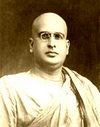
Even from the days of British India, Pune was a haven for scholars and men of learning. Many such intellectuals were greatly inspired by the stirring lectures of Swami Vivekananda and invited monks from the Ramakrishna Math and Mission to deliver talks in the city. Swami Sarvanandaji, a senior monk of the Ramakrishna Order visited Pune in around 1920-1930. A well versed Sanskrit scholar, Sarvanandaji’s translations of the Upanishads are still published and well-read. His scholarly and eloquent lectures deeply influenced the youth of the area who had invited him. Learning of the power of organization from him, they came together and formed the Vivekananda Society on 25 January, 1927.

Gurudev Ranade, the eminent scholar-mystic, was the first president of the society and Sardar Mudliar was the vice president. The aim of the Society was to propagate the liberal ideals of Vedanta as embodied through the lives of Sri Ramakrishna, Sri Sarada Devi and Swami Vivekananda – through the medium of lectures and books. The year 1953-54 was the birth anniversary centenary year of the Holy Mother, Sri Sarada Devi. The event was celebrated with great enthusiasm. It was a step forward to the foundation of the future Ramakrishna Math.
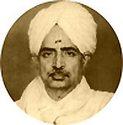
Shri Mamasaheb Dandekar, a great spiritual leader and Kirtankaar of the Varkhari Sampradaya, was elected president of the Society in 1954. The work of the Society continued under the able guidance and leadership of Shri Dandekar. Under his leadership, the Society’s activities gained momentum and regular discourses on spirituality began attracting the general public.
In 1955, a piece of land measuring roughly 6 acres, was purchased, at the foothills of Parvati, a small hillock of immense scenic beauty at that time. Revered Srimat Swami Vireshwaranandaji, the then General Secretary of the worldwide Ramakrishna Math and Mission, Belur, laid the foundation stone for a new temple.
On the auspicious occasion of the birth anniversary of the Holy Mother Sri Sarada devi, 1957, the Ramakrishna Temple was inaugurated by Rev. Vireshwaranandaji and the Society formally changed its name to Ramakrishna Ashram.
Ramakrishna Ashram

In the beautiful environment of the Ashram, there was a temple, prayer hall and a small library with about 1500 books and a few periodicals. The Ashram had 6-7 publications in the form of small Marathi booklets at that time. Bordering the south-east border of the Math premises, an irrigation canal was built by the Government. A monastery (Sadhu Nivas) was constructed during this period. Shri Mamasaheb Dandekar lived in the monastery in those days.Many monks of the Ramakrishna order began visiting the Society and stayed in the monastery. Their stirring lectures were instrumental in spreading of the Ramakrishna-Vivekananda ideology in this area.
In 1971, a small hostel with three rooms for students was built in the eastern corner of the Ashram to accommodate college students, who also could help in the daily running of the Ashram. This hostel continued to run for many years until it was closed down in the early 80s. The small building is still used by the Math to provide temporary accommodation for volunteers etc. during Utsavs and celebrations.
Ramakrishna Math
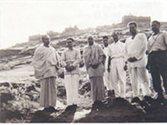
In the year 1960, the then trustees of the Ashram had passed an unanimous resolution to transfer their assets to the Ramakrishna Math, Belur Math unconditionally. Shri Bhausaheb Bodas and Shri Shankarrao Jathar served the Ashram with immense devotion. Their contribution to the growth of the Ashram was truly invaluable. Prof. Shivajirao Bhosale, the well-known academic, delivered Marathi lectures on Swami Vivekananda and Sri Ramakrishna regularly. His lectures were usually well-attended. There was a great contribution from several donors, architects, artists, printers to the growth of the Ashram.

A simple handing-over-function took place on the birthday of Swami Ramakrishnanandaji in July 1984. OnDecember 26, 1984, the Ashram was finally affiliated to the Ramakrishna Math, Belur. Most Rev. Srimat Swami Vireshwaranandaji, President, Ramakrishna Math and Mission presided over the function, which was well-attended by many senior monks including Swami Hiranmayanandaji and other trustees of the order. Swami Bhaumanandaji was appointed as the president of the new Math.
With changing times, the shrine had to be relocated to a more spacious area. Rev. Gambhiranandaji Maharaj, who was the President of the Order, presided over a simple function organized on 29th March, 1989 to inaugurate the new temple.
Within a short span of twelve years, the devotees increased manifold and a larger temple with more facilities had to be conceived of. A beautiful temple called the ‘Universal Temple of Sri Ramakrishna’, which could seat about 500 devotees at a time, was built with many modern facilities.
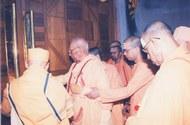
Most Rev. Ranganathanandaji Maharaj, the 13th President of the Order inaugurated the temple on the auspicious day of Ramnavami, 2002. Many sadhus and devotees from all over the world attended the inauguration function. Many spiritual retreats, cultural functions, talks and discourses, bhajans, all-religion-meeting, etc. marked the event.
Pune, being referred to as the ‘Oxford of the East’, is a fast-growing city. The activities of the Pune Ramakrishna Math have multiplied over the time. Many youth, parents, doctors, aspirants attend the many retreats organized by us. We invite you to visit the Math.
